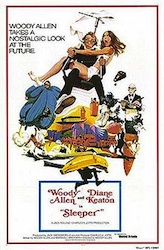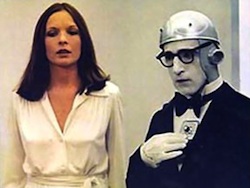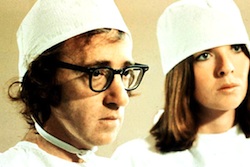In the climactic scene of the gripping dramatic dystopia film Sleeper, two freedom fighters posing as government cloners are attempting to thwart a complex procedure that will resurrect a nearly dead Orwellian figure known as “the Leader.” Though deft and cunning, these two masterminds eventually have their covers blown. After they claim to attempt to clone the Leader directly into his suit so that he will be “completely dressed” (a first in cloning!), the brainwashed agents of the draconian Leader are suddenly on to our heroes and an epic chase ensues. Luckily, these two vanguards of free will and humanity shrewdly hold hostage the only piece of genetic material remaining of the tyrannical Leader; the Leader’s nose. The film’s deeper themes on the notions of what society has lost in this twisted dark future are augmented and driven home by outrageous slapstick music, specifically a spirited jazz clarinet.
Nothing says dystopia like slapstick jazz clarinet. Did I mention the orgasmatron? Read on to discover the true pathos of Woody Allen’s Hugo-Award Winning science fiction dystopia, Sleeper.
 Though what I’m about to say is probably beaten into the brains of film students ad nauseum, it still bears repeating that Woody Allen’s ability to write within seemingly any genre is remarkable. While Sleeper might appear to be his only science fiction film, one could certainly make strong arguments for Zelig (the story of a shapeshifter) or even Stardust Memories (which features an conversation between Allen and a group of aliens). But it is with Sleeper where his ability to blend what was then his trademark slapstick comedy style with a seemingly off-the-rack science fiction premise, demonstrates his true acrobatics as both a writer and a director.
Though what I’m about to say is probably beaten into the brains of film students ad nauseum, it still bears repeating that Woody Allen’s ability to write within seemingly any genre is remarkable. While Sleeper might appear to be his only science fiction film, one could certainly make strong arguments for Zelig (the story of a shapeshifter) or even Stardust Memories (which features an conversation between Allen and a group of aliens). But it is with Sleeper where his ability to blend what was then his trademark slapstick comedy style with a seemingly off-the-rack science fiction premise, demonstrates his true acrobatics as both a writer and a director.
 Sleeper tells the story of a man from the 20th century unfrozen (ala Buck Rogers) 200 years in his future into a very different America. Allen and his co-writer Marshall Brickman employ numerous tropes of a futuristic police state right off the bat, complete with leather-clad enforcers who get their fashion tips from the THX 1138 gang. Free will has also been completely taken away in all forms, and even physical sex has been reduced to mechanization. The scientists who have unfrozen Miles Monroe (Allen) are part of a secret rebel cell working against the draconian government in an attempt to stop a horrific plot known only in whispers as “The Aries Project.” You know what kind of movie you’re getting into in this first scene as a highly sedated Woody Allen narrowly escapes in an outrageous slapstick chase which is punctuated by that jazz music mentioned earlier.
Sleeper tells the story of a man from the 20th century unfrozen (ala Buck Rogers) 200 years in his future into a very different America. Allen and his co-writer Marshall Brickman employ numerous tropes of a futuristic police state right off the bat, complete with leather-clad enforcers who get their fashion tips from the THX 1138 gang. Free will has also been completely taken away in all forms, and even physical sex has been reduced to mechanization. The scientists who have unfrozen Miles Monroe (Allen) are part of a secret rebel cell working against the draconian government in an attempt to stop a horrific plot known only in whispers as “The Aries Project.” You know what kind of movie you’re getting into in this first scene as a highly sedated Woody Allen narrowly escapes in an outrageous slapstick chase which is punctuated by that jazz music mentioned earlier.
Uniquely, this is one of the few Woody Allen films with a soundtrack featuring music performed by Allen himself. This is a nice in-universe nod to Allen’s character Miles who played in a jazz band called The Ragtime Rascals prior to being put in suspended animation. And though I’ve been making jokes about the poignancy of the music in Sleeper, I really do feel that the slapstick scenes combined with the ragtime tunes drive home the point of what dystopia fiction is all about. That being, that even in dire and dark times, our quirky humanity somehow makes it through. In Sleeper, this is represented quite literally by slapstick. A lot will be written this week about whether dystopias are really hopeful narratives masquerading as downers and as such are sort of “topping from the bottom.” And I think in most ways, Sleeper fits this bill.
And yet, Sleeper manages mix it up a bit with the notion that even in a society with overt thought-control, there is still an elite class of socialites who have cocktail parties in which they talk about absolutely nothing and partake in fashionable narcotics. When we first meet her, Diane Keaton’s character, Luna, it depicted as the worst of these kinds of socialites, and save for all the over-the-top comedy, is indistinguishable from her characters in Annie Hall and Manhattan. The fact that in a mind-controlled Orwellian society that there is still a bunch of pseudo-intellectual banter going on about art is actually a pretty dark statement from Woody Allen if you stop to think about it. Are even our petty distractions being orchestrated and tolerated by a larger thought-controlling machine? It’s subtle, but the notion is certainly there.
The most important thing about Sleeper is that it’s extremely funny. Part of why the humor in this movie works so well is that Allen is using imagery familiar to audiences of all sorts of genres. Any child can recognize a classic “slipping on a banana peel” bit, but Woody Allen took it one step further by sort of saying- “What if it was a giant banana peel?”
What if in a dystopian future there was only one restaurant left in America? Well then surely, that restaurant would be McDonalds! This joke works so much better than the running Taco Bell joke in Demolition Man, and not just because this is a good movie and Demolition Man isn’t. The joke works because the basic idea that McDonalds is the only restaurant in the world is already embedded into the popular conciseness. A good dystopia story depicts a world that isn’t actually dissimilar to the world in which we live and demonstrates just how easily we could slide into such a situation.
 Sleeper takes this one step further by also giving us a few things in its dystopia future we might actually want. It’s possible that the orgasmatron might come in handy every once and awhile. Really! Not to mention, even though it doesn’t work properly, there is something pretty cool about the helicopter pack Woody uses to attempt escape in one scene.
Sleeper takes this one step further by also giving us a few things in its dystopia future we might actually want. It’s possible that the orgasmatron might come in handy every once and awhile. Really! Not to mention, even though it doesn’t work properly, there is something pretty cool about the helicopter pack Woody uses to attempt escape in one scene.
Also, I could also go for one of those giant strawberries right about now.
Ryan Britt is a regular blogger for Tor.com. He has been excused of talking like Woody Allen when he has too much to drink.










